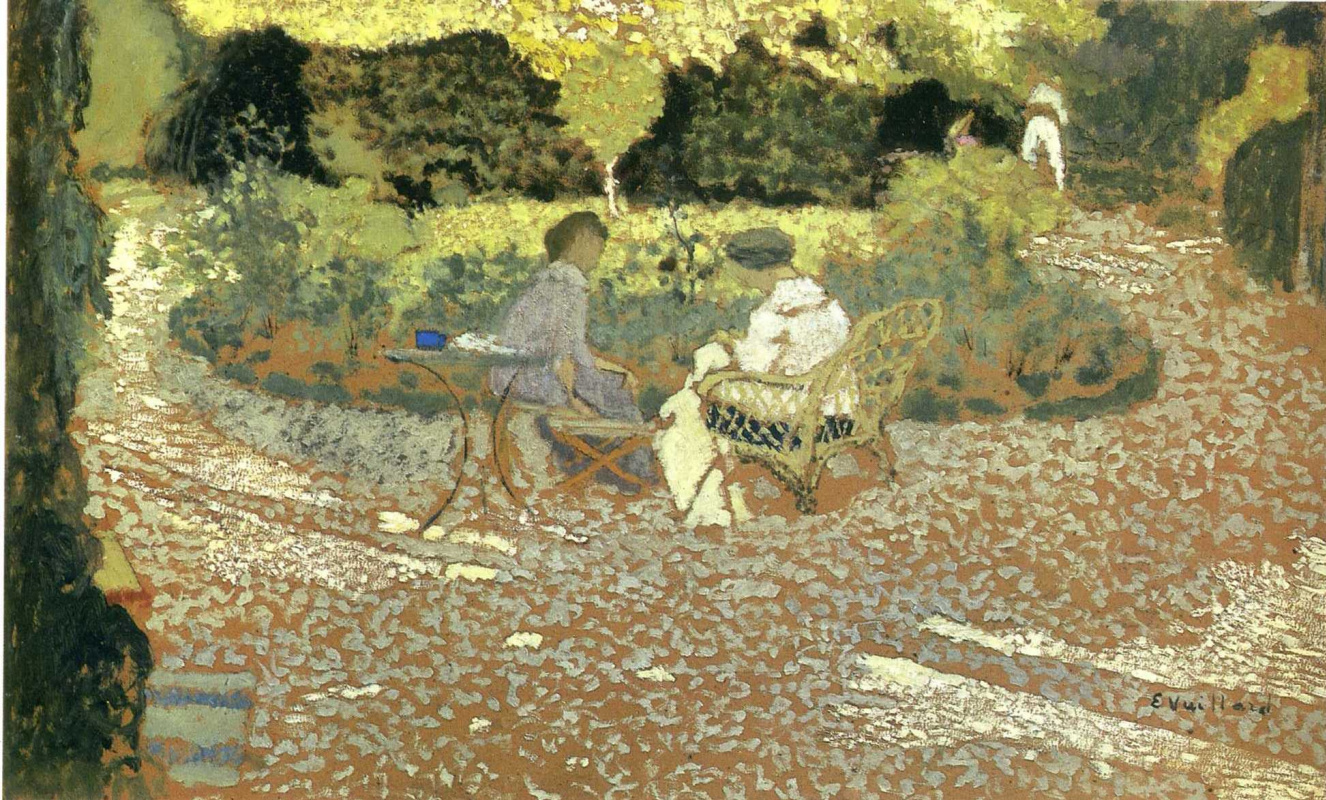log in
Enter site
Login to use Arthive functionality to the maximum
In the Garden
Jean Edouard Vuillard • Painting, 1898, 51×83 cm
Description of the artwork «In the Garden»
For thirty-year-old Vuillard, the years 1898—1899 were the period of his full, almost maniacal, working capacity and popularity. He had already found his individual style, but not his personal art dealer who would have made his life relaxed and carefree. The artistic philosophy of the group Vuillard belonged to — the Nabis, — Gauguin’s influence, the inspiration he took from the Pointillists, Japanese art — all these consolidated into a firm, deep-laid foundation for his style. And above this foundation, there were layers of cultural soil that, on the one hand, spontaneously accumulated with the wind of change, and, on the other hand, was cultivated by Vuillard himself. At that time, he painted his best pictures, small-sized and very intimate, and worked on the lithographic album Landscapes and Interiors, and on his largest canvas First Fruits, measuring 14 feet across. Now he could easily employ graphic and decorative techniques in his paintings, and, vice versa, use the techniques of painting in decorative art.
In the Garden is painted in tempera on cardboard — and it is more than just a technique. Vuillard left some areas of the cardboard surface unpainted, and did it in quite a novel way. Before him, Impressionists had been doing so to make their works look like sketches, to emphasize the fleeting nature of the landscape. But if you look closely at Vuillard’s work, you can see that the color of the surface is the keynote of the picture, and the paints are the negative space for the keynote. The paints help us to see in the unpainted spots the legs of the chair, folds of the dress, or clods of earth on the flowerbed. Though the figures are quite discernible, they do not catch our eye, but blend in with their surroundings. The only thing we can focus on is the small ultramarine object on the table — perhaps a casket, or a vase. It serves here as the point of equilibrium.
It is Vuillard’s favourite trick — showing people through the objects, interiors, and landscapes that surround them. Wallpaper patterns, spots on garden alleys, desk lamps, flowerbeds — everything contributes to the representation of a subject’s inner life, shades of emotions, symbolic, abstract, and even social connotations. Colors and patterns are constantly tested for how expressive they are: whether they can be more eloquent than the traditional ways of painting a realistic psychological portrait or a genre composition. How will it look with fewer means of expression used? Or if we only paint in half-tones? Or if we, instead of traditional canvas, take cardboard that absorbs paints and takes gloss off the surface? While experimenting like this, in the 1890s, Vuillard did not varnish his pictures and used cardboard more and more often. To achieve the effect of a matt, subdued surface, he invented a complex mixture of oil paints and an adhesive solution of tempera.
In this search, both technical and emotional, In the Garden is a challenging and masterly attempt of speaking in half tones only, hinting rather than saying things straightforwardly, with as few means of expression as possible.
Author: Anna Sidelnikova
In the Garden is painted in tempera on cardboard — and it is more than just a technique. Vuillard left some areas of the cardboard surface unpainted, and did it in quite a novel way. Before him, Impressionists had been doing so to make their works look like sketches, to emphasize the fleeting nature of the landscape. But if you look closely at Vuillard’s work, you can see that the color of the surface is the keynote of the picture, and the paints are the negative space for the keynote. The paints help us to see in the unpainted spots the legs of the chair, folds of the dress, or clods of earth on the flowerbed. Though the figures are quite discernible, they do not catch our eye, but blend in with their surroundings. The only thing we can focus on is the small ultramarine object on the table — perhaps a casket, or a vase. It serves here as the point of equilibrium.
It is Vuillard’s favourite trick — showing people through the objects, interiors, and landscapes that surround them. Wallpaper patterns, spots on garden alleys, desk lamps, flowerbeds — everything contributes to the representation of a subject’s inner life, shades of emotions, symbolic, abstract, and even social connotations. Colors and patterns are constantly tested for how expressive they are: whether they can be more eloquent than the traditional ways of painting a realistic psychological portrait or a genre composition. How will it look with fewer means of expression used? Or if we only paint in half-tones? Or if we, instead of traditional canvas, take cardboard that absorbs paints and takes gloss off the surface? While experimenting like this, in the 1890s, Vuillard did not varnish his pictures and used cardboard more and more often. To achieve the effect of a matt, subdued surface, he invented a complex mixture of oil paints and an adhesive solution of tempera.
In this search, both technical and emotional, In the Garden is a challenging and masterly attempt of speaking in half tones only, hinting rather than saying things straightforwardly, with as few means of expression as possible.
Author: Anna Sidelnikova


